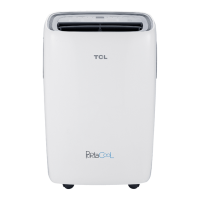Do you have a question about the TCL TAC-12CHSC and is the answer not in the manual?
| Brand | TCL |
|---|---|
| Model | TAC-12CHSC |
| Category | Air Conditioner |
| Language | English |
Instructions for ordering replacement components, detailing required information.
Diagram illustrating the heat pump refrigeration cycle.
Diagram illustrating the cooling-only refrigeration cycle.
Key parameters for performance evaluation: voltage, airflow, and readings.
Procedure for measuring temperature differences for performance analysis.
Performance curves detailing outdoor low pressure and unit current during cooling.
Explanation of remote control buttons, modes, and operation.
Instructions for setting the remote controller for unit type.
Details on safety controls like time delay and frost prevention.
Logic and operation details for 'I Feel' and 'Cooling' modes.
Explanation of the DRY mode's operational sequence.
HEATING mode logic and Cold Air Prevention Control.
Conditions, termination, and chart for the defrost cycle.
Role of the assistant thermistor in heating capacity.
Details on the operation of the FAN mode.
Operation of the 4-way valve for switching between modes.
Functionality and timing of the SLEEP mode.
Fan speed control via frequency feedback and auto settings.
Control of vane movement for optimal air distribution.
Procedures for setting and canceling timer functions.
Emergency operation switch and auto-restart function.
Identifying failures via lamp flashes and digital pipe codes.
Steps to take for specific component failures.
Electrical schematic for the indoor unit's components.
Electrical schematic for the outdoor unit's components.
Specific parts list for TAC-07CS/K and TAC-09CS/K models.
Specific parts list for TAC-07CHS/K and TAC-09CHS/K models.
Specific parts list for TAC-07CSC/K and TAC-09CSC/K models.
Specific parts list for TAC-07CHSC/K and TAC-09CHSC/K models.
Specific parts list for TAC-12CS/K and TAC-12CSC/K models.
Specific parts list for TAC-12CHS/K and TAC-12CHSC/K models.
Parts list for TAC-18/24K CS/CSC models.
Parts list for TAC-18/24K CHS/CHSC models.
Parts list for TAC-07/09K CS models.
Parts list for TAC-07/09K CSC models.
Parts list for TAC-07/09K CHS models.
Parts list for TAC-07/09K CHSC models.
Parts list for TAC-12K CS models.
Parts list for TAC-12K CSC models.
Parts list for TAC-12K CHS models.
Parts list for TAC-18K CS models.
Parts list for TAC-18K CSC models.
Parts list for TAC-18K CHS models.
Parts list for TAC-18K CHSC models.
Parts list for TAC-24K CS models.
Parts list for TAC-24K CSC models.
Parts list for TAC-24K CHS models.
Parts list for TAC-24K CHSC models.
List of topics covered in Annex 2: General Information.
Categorization of ACs based on cooling, heating, or combined functions.
Categorization of ACs based on installation methods like window or split.
Defines temperature, humidity, purity, airflow, and comfort levels.
Explanation of cooling through evaporation and refrigerant properties.
Visual representation of the refrigeration cycle components.
Function of compressor, condenser, evaporator, and capillary tube.
Definitions for air conditioning, capacity, humidity, and purity.
Explanation of radiation, conduction, and convection heat transfer.
Definitions of Kcal, BTU, RT, Hp and unit conversion tables.
Detailed functions of compressor, condenser, evaporator, dryer, etc.
How refrigerant states change during the cycle on a Mollier diagram.
Steps to draw a refrigerating cycle on the Mollier diagram.
Formula for calculating the refrigerating effect (qe).
Formula for calculating the work of compression (Al).
Formula for calculating the calorie of condensation (q2).
Calculating the refrigerant circulation amount (G).
Formula and interpretation of the Coefficient of Performance.
Understanding the psychrometric chart and its parameters.
Definition, calculation, and interpretation of the discomfort index.
Explanation of condensation (dewing) and its causes.
Strategies and guidelines to prevent dewing.
Method for calculating combined sound levels from multiple sources.
Formulas for calculating sound pressure level attenuation.
Noise Criteria (NC) curves and levels for various environments.
Factors contributing to cooling/heating load: walls, glass, occupants, etc.
Guideline for estimating calorie requirement based on area.
Factors influencing AC capacity selection like insulation and occupancy.
Method for estimating required capacity with adjustments.
Instructions for using the chart to select unit size.
List of categories for troubleshooting.
Checking working power, voltage drop, and wire capacity.
Table specifying wire gauge based on rated current.
Checking insulation resistance of wires and compressor.
Procedures for testing running capacitor earth and capacity.
Diagnosing motor fan issues via resistance and independent tests.
Identifying thermostat malfunctions like leaks or wiring errors.
Procedure for testing thermistor continuity and resistance.
Diagnosing electrical issues: ground test, wiring, and OLP.
Diagnosing issues when the compressor doesn't start.
Identifying and resolving poor compression problems.
Troubleshooting overcurrent issues while the compressor runs.
Basic checks for refrigerant system issues.
Analyzing temperature differences for refrigerant problems.
Typical pressure and temperature readings for normal operation.
Diagnosing issues based on pressure and temperature deviations.
Symptoms and actions for refrigerant shortage.
Diagnosing and fixing blockages in the refrigerant system.
Identifying and rectifying refrigerant overcharge issues.
Methods to diagnose and address bad compressor compression.
Table summarizing common refrigerant system causes and checks.
Safety and procedural guidelines for refrigerant system repairs.
Flowchart for diagnosing complete unit failure.
Flowchart for diagnosing room fan failure.
Flowchart for diagnosing compressor or outdoor fan failure.
Flowchart for diagnosing up/down vane operational failure.
Flowchart for diagnosing left/right louver operational failure.
Flowchart for diagnosing issues with remote control settings.
Flowchart for diagnosing failure in mode conversion.
Proper pipe cutting technique to prevent gas leaks.
Importance of removing pipe burrs after cutting.
Accurate sizing during flaring to prevent leaks.
Proper torque specifications for flare nut fastening.
Ensuring proper indoor unit leveling and drain hose connection.
Correct methods for extending and laying drain hoses.
Preventing upward drain hose and clogs for proper drainage.
Proper insulation of tubing connections and hidden parts.
Preventing water leaks using U-traps and proper taping.
Correct freon addition after extending tubing.
Ensuring adequate spacing for split unit air intake and discharge.
Ensuring adequate spacing for window unit air intake and discharge.
Proper outdoor unit installation and awning for airflow.
Using correct tubes and bending tools to maintain cooling capacity.
Recommended tubing distances and height differences.
Ensuring stable installation and tight fittings to prevent noise.
Securing surplus tubing to prevent vibration and noise.
Correct wiring of 3-phase power lines and phase matching.
Checking and ensuring proper cable insulation.
Using drain traps to prevent smells and gases.
Properties and handling of R407c refrigerant.
Key differences in charging, composition, and leak detection.
Instructions for installing wall-mounted split type air conditioners.
Temperature-pressure relationships and freon properties.
List of essential tools for installation.
Tools for assembly, measurement, and connection.
Various accessories used during the installation process.
Guidelines for choosing optimal indoor and outdoor unit locations.
Specifications for refrigerant pipe length and height difference.
Procedures for mounting the indoor unit installation plate.
Steps for drilling the wall hole for piping connections.
Steps for preparing pipes, including cutting and deburring.
Performing flaring and verifying the flare quality.
Routing and connecting indoor unit piping, drain hose, and cables.
Mounting the indoor unit and connecting the drain hose.
Connecting pipes and cables to the outdoor unit.
Wiring the indoor unit to the control board.
Wiring the outdoor unit and installing circuit breakers.
Procedures for checking and forming drain piping.
Methods for routing and securing piping.
Importance of removing air and moisture from the system.
Steps for purging air using a vacuum pump.
Connecting vacuum pump and evacuating the system.
Final steps: valve operation, leak checks, and system readiness.
Using soap water to identify leaks in piping connections.
Preparing the remote control for test running.
Securing the outdoor unit for stability during operation.
Checking refrigerant charge and air temperatures.
Procedure to collect refrigerant in the outdoor unit.












